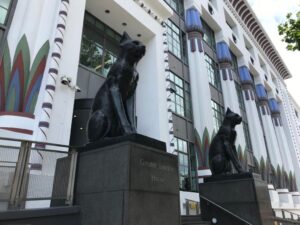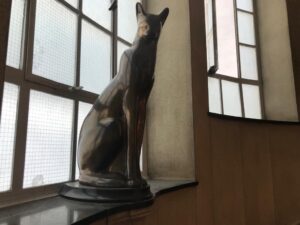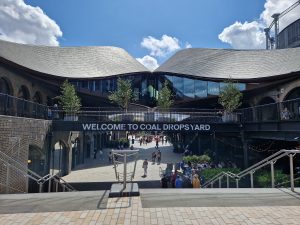The London borough of Camden appears to have an adoration for our furry feline friends. As one explores the streets, numerous tributes and statues of cats become evident, etching their mark on the region’s rich tapestry.
Undoubtedly, the most famous feline tributes are the colossal cat statues adorning the entrance of Greater London House, an imposing Art Deco office building situated opposite Mornington Crescent underground station. This architectural marvel, inspired by the early 20th-century Egyptian Revival, mirrors the influence of Howard Carter’s discovery of Tutankhamun’s tomb in 1922 and the fascination with Egyptian themes in design that it sparked.
The building was initially known as the Carreras Building, a homage to the Paris Exhibition of 1925 and the fascination with Ancient Egypt presented in Hollywood films. The grand unveiling of this structure was nothing short of dramatic; a ceremony involving covering the nearby pavements with sand to mimic the Egyptian desert, a procession featuring cast members from a London production of Verdi’s Aida, actors in Ancient Egyptian attire, and a chariot race on Hampstead Road. The building, originally a cigarette factory, boasted the image of a black cat on its cigarette packets, earning it the local nickname of the ‘Black Cat factory’.

However, the iconic feline guardians were removed in 1959 when Carreras merged with Rothmans and relocated to a new factory in Essex. One cat was moved to Essex, the other exported to Jamaica, leaving the building cat-less. Over time, the factory fell into disrepair until it was converted into offices in 1961. Stripped of its Egyptian decoration to present a modernist appearance, it was renamed Greater London House. In 1996, the building was refurbished, reinstating around 80-90% of the original Art Deco features, including replicas of the celebrated cat statues. Since 2018, it has served as the headquarters for ASOS.

In the vicinity on Royal College Street, numerous cats and other animals decorate the railings of the Royal Veterinary College, guiding visitors to the Beaumont Sainsbury Animal Hospital, one of London’s oldest veterinary clinics established in 1932.

Tucked away in Queen Square, Bloomsbury, you can find a life-sized statue of a cat named Sam, an affectionate tribute to Patricia Penn, a local champion of community causes and cat lover. After being stolen in 2007, Sam was replaced in 2009, now secured with steel rods to his designated piece of wall.


Further clues to Camden’s love for cats can be seen in Tottenham Court Road at the Heals furniture store. Here, a cat’s playful sketch on the window hints at its role as the shop’s mascot. The store features a bronze cat statue presiding over the spiral staircase, symbolising the store’s mascot and a tribute to Sir Ambrose Heal’s influence on the store.

Camden’s most recent feline addition pays homage to Sir Matthew Flinders and includes his companion, Trim, positioned in front of Euston station. This black and white cat accompanied Flinders in mapping the coast of Australia in 1802, impressively learning to swim and showing an affinity for navigation. Their collective tributes, mostly in Australia, commemorate their three circumnavigations of Australia and one of the world.
Maggie’s Magical Bloomsbury walk starts at the statue of Trim (outside Euston station) as cats have always had connections with the magical.




